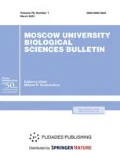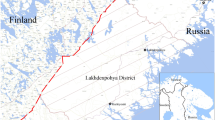Abstract
Study into the effect of vitamins A and E on total and differential leukocyte count, as well as morphometric parameters of lymphocytes in three carnivorous species—dark brown American mink (Neovison vison, Mustelidae), blue fox (Vulpes lagopus, Canidae), and silver fox (V. vulpes, Canidae)—was conducted. The highest white blood cells count (WBC count) and the largest surface area of lymphocytes and their nuclei in the peripheral blood were observed in mink, while the lowest indices were found in silver fox. Additional supplementation with vitamins A and E for 14 days had no effect on the WBC and differential leukocyte count, except for silver foxes receiving vitamin E, in which a decrease in relative eosinophils and monocytes content was observed. The action of vitamins was mainly manifested in changes in the lymphocytes’ morphometric parameters. The addition of vitamin A into the diet of mink and silver fox and vitamin E into only mink’s diet led to an increase in the surface area of lymphocytes and, in some cases, their nuclei, which was accompanied by a rise in the cytoplasm size in mink cells. In blue fox, on the contrary, both vitamins induced a decrease in the surface area of the lymphocytes and their nuclei. The observed changes may be associated with the immunomodulatory effects of vitamins A and E of the studied species of carnivorous mammals, while the found differences may be associated with features of the morphologic and functional organization of lymphocytes and the immune status.


Similar content being viewed by others
REFERENCES
Ross, A.C., Chen, Q., and Ma, Y., Vitamin A and retinoic acid in the regulation of B-cell development and antibody production, Vitam. Horm., 2011, vol. 86, no. 5, pp. 103–126.
Chen, X., Esplin, B.L., Garrett, K.P., Welner, R.S., Webb, C.F., and Kincade, P.W., Retinoids accelerate B lineage lymphoid differentiation, J. Immunol., 2008, vol. 180, no. 1, pp. 138–145.
Pekmezci, D., Vitamin E and immunity, Vitam. Horm., 2011, vol. 86, no. 8, pp. 179–215.
Galli, F., Azzi, A., Birringer, M., Cook-Mills, J.M., Eggersdorfer, M., Frank, J., Cruciani, G., Lorkowski, S., and Özer, N.K., Vitamin E: Emerging aspects and new directions, Free Radic. Biol. Med., 2017, vol. 102, pp. 16–36.
Han, S.N., Adolfsson, O., Lee, C.-K., Prolla, T.A., Ordovas, J., and Meydani, S.N., Vitamin E and gene expression in immune cells, Ann. N. Y. Acad. Sci., 2004, vol. 1031, no. 1, pp. 96–101.
Korhonen, H.T. and Huuki, H., Effect of carotenoid supplement on production performance in mink (Neovison vison), Open J. Vet. Med., 2015, vol. 5, no. 4, pp. 73–79.
Berestov, V. and Brandt, A., Erythrocytes and leucocytes, in Haematology and Clinical Chemistry of Fur Animals, Brandt, A., Ed., Jyvväskylä: Gummerus Kirjapaino Oy, 1989, pp. 22–33.
Salakij, C., Salakij, J., Narkkong, N.A., Prihirunkit, K., Kamolnorranath, S., and Apibal, S., Haematology, cytochemical and ultrastructural characteristics of blood cells in leopard (Panthera pandus), Comp. Clin. Pathol., 2009, vol. 18, no. 2, pp. 153–161.
Nunn, C.L., Gittleman, J.L., and Antonovics, J., A comparative study of white blood cell counts and disease risk in carnivores, Proc. Biol. Sci., 2003, vol. 270, no. 1513, pp. 347–356.
Scanes, C.G., Allometric and phylogenic comparisons of circulating leukocyte concentrations between and within birds and mammals, Int. J. Vet. Health Sci. Res., 2016, vol. 4, no. 4, pp. 116–122.
Valov, A.L., Vasilenko, I.A., Vatazin, A.V., Troyanskii, I.V., Metelin, V.B., Tsalman, A.Ya., and Vishenskaya, T.V., Vital computed lymphocyte morphometry as a non-invasive method for diagnosing acute rejection of the renal allograft, Al’m. Klin. Med., 2009, no. 20, pp. 77–82.
Aasted, B., Mink infected with Aleutian disease virus have an elevated level of CD8-positive T-lymphocytes, Vet. Immunol. Immunopathol., 1989, vol. 20, no. 4, pp. 375–385.
Almazov, V.A., Afanas’ev, B.V., Zaritskii, A.Yu., Mamaev, N.N., Rudakova, T.L., Freidlin, I.S., Tsveibakh, A.S., and Shishkov, A.L., Fiziologiya leikotsitov cheloveka (Physiology of Human Leukocytes), Leningrad: Nauka, 1979.
Uzenbaeva, L.B., Baishnikova, I.V., Kizhina, A.G., Il’ina, T.N., Ilyukha, V.A., and Tyutyunnik, N.N., Morphometric parameters of peripheral blood lymphocytes of foxes (Vulpes vulpes L.) and arctic foxes (Alopex lagopus L.) under the influence of various doses of vitamins A and E, Tr. Karel. Nauchn. Tsentra Ross. Akad. Nauk, 2014, no. 5, pp. 78–85.
Baishnikova, I., Sergina, S., and Ilyina, T., Effect of vitamin E supplementation on α-tocopherol status and tissue antioxidants in American minks (Neovison vison), Turk. J. Vet. Anim. Sci., 2018, vol. 42, no. 6, pp. 642–648.
Engedal, N., Ertesvag, A., and Blomhoff, H.K., Survival of activated human T lymphocytes is promoted by retinoic acid via induction of IL-2, Int. Immunol., 2004, vol. 16, no. 3, pp. 443–453.
Hall, J.A., Grainger, J.R., Spencer, S.P., and Belkaid, Y., The role of retinoic acid in tolerance and immunity, Immunity, 2011, vol. 35, no. 1, pp. 13–22.
Azzi, A., Many tocopherols, one vitamin E, Mol. Aspects Med., 2018, vol. 61, pp. 92–103.
Zingg, J.-M., Han, S.N., Pang, E., Meydani, M., Meydani, S.N., and Azzi, A., In vivo regulation of gene transcription by alpha- and gamma-tocopherol in murine T lymphocytes, Arch. Biochem. Biophys., 2013, vol. 538, no. 2, pp. 111–119.
Viti, V., Cicero, R., Callari, D., Guidoni, L., Billitteri, A., and Sichel, G., Effect of lipophilic vitamins on the erythrocyte membrane. 31P NMR and fluorescence studies, FEBS Lett., 1983, vol. 158, no. 1, pp. 36–40.
Uzenbaeva, L.B., Baishnikova, I.V., Kizhina, A.G., Il’ina, T.N., Ilyukha, V.A., and Tyutyunnik, N.N., Morphological features of peripheral lymphocyte blood of arctic foxes with the introduction of vitamins A and E in various doses, Morfologiya, 2013, no. 3, pp. 39–44.
Miller, R.R., Jr., Cornett, C.L., Waterhous, K.E., and Farstad, W., Comparative aspects of sperm membrane fatty acid composition in silver (Vulpes vulpes) and blue (Alopex lagopus) foxes, and their relationship to cell cryopreservation, Cryobiology, 2005, vol. 51, no. 1, pp. 66–75.
Rouvinen, K., Dietary effects of omega-3 polyunsaturated fatty acids on body fat composition and health status of farm-raised blue and silver foxes, Acta Agric. Scand., 1991, vol. 41, no. 4, pp. 401–414.
Rouvinen, K. and Kiiskinen, T., Influence of dietary fat source on the body fat composition of mink (Mustela vison) and blue fox (Alopex lagopus), Acta Agric. Scand., 1989, vol. 39, no. 3, pp. 279–288.
Il'ina, T.N. and Baishnikova, I.V., Species-specific features of tocopherol content in carnivorous mammals in autumn, J. Evol. Biochem. Phys., 2015, vol. 51, no. 1, pp. 41–47.
Funding
Financial support for research was provided by the federal budget for the fulfillment of the state assignment of the Karelian Research Center, Russian Academy of Sciences (project number 0218-2019-0073).
Author information
Authors and Affiliations
Corresponding author
Ethics declarations
Conflict of interests. The authors declare that they have no conflict of interest.
Statement on the welfare of animals. The work was performed in compliance with the international principles of the Helsinki Declaration on the Humane Attitude towards Animals. The experiments were conducted in compliance with the ethical standards of work with animals established by the Ethical Commission of the Institute of Biology, Karelian Research Center, Russian Academy of Sciences.
Additional information
Translated by I. Shipounova
About this article
Cite this article
Baishnikova, I.V., Uzenbaeva, L.B., Ilyukha, V.A. et al. Comparative Research into the Effect of Vitamins A and E on the Differential Leucocyte Count and the Morphometric Parameters of Lymphocytes in Carnivorous Mammals (Carnivora). Moscow Univ. Biol.Sci. Bull. 74, 49–56 (2019). https://doi.org/10.3103/S0096392519020019
Received:
Revised:
Accepted:
Published:
Issue Date:
DOI: https://doi.org/10.3103/S0096392519020019



